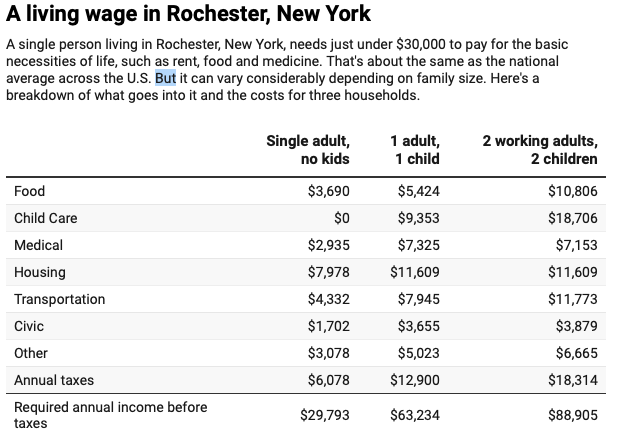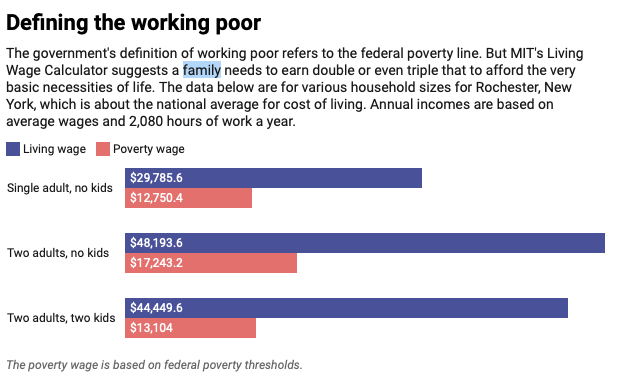Jeffrey Kucik and Don Leonard consider what it takes to survive in today’s America.

Retail employees such as cashiers are among the least-paid U.S. workers. (AP/Wilfredo Lee)
On Thursday the U.S. Supreme Court overturned President Joe Biden’s moratorium on evictions in response to the pandemic, which has devastated the economy. “If a federally imposed eviction moratorium is to continue,” the majority opinion said, “Congress must specifically authorize it.” This article lays out what a disaster that will be for millions of Americans who, even in normal times, can hardly pay for housing, a basic human right.
By Jeffrey Kucik and Don Leonard
The Conversation

 The Biden administration is likely celebrating a better-than-expected jobs report, which showed surging employment and wages. However, for millions of working Americans, being employed doesn’t guarantee a living income.
The Biden administration is likely celebrating a better-than-expected jobs report, which showed surging employment and wages. However, for millions of working Americans, being employed doesn’t guarantee a living income.
As scholars interested in the well-being of workers, we believe that the economy runs better when people aren’t forced to choose between paying rent, buying food or getting medicine. Yet too many are compelled to do just that.
Determining just how many workers struggle to make ends meet is a complicated task. A worker’s minimum survival budget can vary considerably based on where the person lives and how many people are in the family.
Take Rochester, New York. It has a cost of living that’s closest to the national average across 509 U.S. metropolitan areas, according to the City Cost of Living Index compiled by the research firm AdvisorSmith.
MIT’s living wage calculator shows that a single adult living in Rochester needs at least $30,000 a year to cover the cost of housing, food, transportation and other basic needs.
But in San Francisco, which AdvisorSmith data indicate is the U.S. city with the highest cost of living, affording just the basics costs $47,587, mainly due to significantly higher taxes and rents.

(The Conversation, CC-BY-ND Source: MIT Living Wage Calculator, AdvisorSmith City Cost of Living Index Get the data)
The city with the lowest cost of living is Beckley, West Virginia. Even there, a childless worker still needs to earn about $28,200 to make essential ends meet. Again, the average American city has a cost of living of around $30,000 a year for a single person.
Of course, costs add up quickly for households with more than one person. Two adults in Rochester need over $48,000 a year, while a single parent with one child needs more than $63,000. In San Francisco, a single parent would need to earn $101,000 a year just to scrape by.
So that’s what it takes to survive in today’s America. About $30,000 a year for a single person without dependents in the average city – a little less in some cities, and much, much more for families and anyone who lives in a major city like San Francisco or New York.
But we estimate that at least 27 million U.S. workers don’t earn enough to hit that very low threshold of $30,000, based on the latest occupation wage data from the Bureau of Labor Statistics, a government agency, from May 2020. We believe this is a conservative estimate and that the number of people with jobs who earn less than what’s necessary to afford the necessities of life is likely much higher.
Low-Income Occupations
Low-income occupations encompass a wide range of jobs, from bus drivers to cleaners to administrative assistants. However, the majority of those 27 million workers are concentrated in two industries: retail trade and leisure and hospitality. These two industries are among America’s largest employers and pay the lowest average wages.
For example, the median salary for cashiers was $28,850 in early 2020, with 2.5 million of the nation’s 5 million cashiers earning less than that. Or take retail sales. There, 75 percent of workers — about 1.8 million — were earning less than $27,080 a year.
It’s the same story for leisure and hospitality, the industry that took the hardest hit from the Covid-19 pandemic, hemorrhaging 6 million jobs in April 2020 as much of the U.S. economy shut down. At the time, close to a million waiters and waitresses were earning less than the median income of $23,740.
Of course, millions of those jobs have returned, and wages have been surging this year — though only slightly more than inflation. But that doesn’t change the basic math that roughly 1-in-6 workers is making less than what’s necessary for an adult with no kids to survive.
That’s why it’s hardly surprising that 40 percent of U.S. households reported in 2018 that they couldn’t afford an emergency $400 expense.
To us, these figures should cause policymakers to redefine who counts among the “working poor.” A 2021 Bureau of Labor Statistics report estimated that in 2019 about 6.3 million workers earned less than the poverty rate.

(Chart: The Conversation, CC-BY-ND Source: MIT Living Wage Calculator, Bureau of Labor Statistics Get the data)
But this situation drastically understates the scope of the working poor because the federal poverty line is unrealistically low – only $12,880 for an individual. The official poverty line was created to determine eligibility for Medicaid and other government benefits that support low-income people, not to indicate how much a person needs to actually get by.
Writer James Truslow Adams coined the phrase “The American Dream” in 1931 to describe a society in which he hoped anyone could attain the “fullest stature of which they are innately capable.” That depended on having a good job that paid a living wage.
Unfortunately, for many millions of hard-working Americans, the “better and richer and fuller” life Adams wrote about remains just a dream.
Jeffrey Kucik is assistant professor of political science at the University of Arizona.
Don Leonard is assistant professor of practice in city and regional planning at The Ohio State University.
This article is republished from The Conversation under a Creative Commons license. Read the original article.
The views expressed are solely those of the authors and may or may not reflect those of Consortium News.

The numbers on the bar graph comparing a living wage with the official poverty level don’t agree with the numbers cited earlier in the table.
How could two adults with two kids require less money than with no kids?
The earlier table has the correct figures from the MIT living wage calculator: hXXps://livingwage.mit.edu/metros/40380
Employers can not find workers for good jobs! Get people off the dole and back into the workforce! Restaurants in Newport, RI are closing one and two days a week because they can’t staff the Restaurants.
Well, acording to the MIT living wage calculator cited in the article, a single adult with no kids in Newport, RI needs $31,971 a year to make ends meet, but the typical salary in the “Food Preparation & Serving Related” category is only $26,773.
So it’s not that employers can’t “find workers for good jobs”, it’s that they can’t find workers for shitty jobs where they have to serve assholes like you!
hXXps://livingwage.mit.edu/counties/44005
There are several problems making it “surprisingly difficult” to have a decent living in USA with income that is very comfortable, say, in Poland.
One problem is that in a country with lower nominal income there are many options to spend less on essentials.
One is shelter. In USA, there were cheap options that mostly evaporated and are still scarcer. In urban areas, slums, single occupancy hotels, and public housing — they are less and less available. In smaller towns there were trailer parks that gradually vanish. Rural areas may be much cheaper (I live in central PA), but the industrial jobs in those areas mostly vanished, so that imposes long commutes.
Public transit options could make it affordable to commute with lower income, but in USA it is frequently inadequate to link what affordable housing exists to what job places are available.
Even bigger issue is medical care. The average cost per person is ridiculously high in USA, and it is not like you can choose “cheap medicine”. Obama care fixed the affordability for the poor, but with many blank spots. In most state, with no income you little (I am not sure about affordability of co-payments), but it can be different when you approach a threshold of decent living that is discussed in this article.
A weird issue is the cost of healthy food. In Poland not everybody eats healthily, but healthy food is sufficiently similar to the traditional food that it has the status of cheap staples: the drastic example is “whole grains”. Germany is similar to Poland in that respect. You can choose inexpensive whole grains, fruits and vegetables. In USA, cheap food is almost necessarily unhealthy.
And the remaining categories are smaller, like banking services, but similar issues arise: poor people are clobbered with fees and reduced options.
I’d rather my government squander my tax dollars on keeping domestic deadbeats housed, clothed and fed, so they are not tempted to steal and attack their fellow Americans fortunate enough to have a job with a living wage, rather than devote that money, as they shamelessly do, to the pursuit of pure evil in endless wars on the other side of the planet against other peoples who simply want to control their own destinies. Our own people should not want just so our leaders can bully and boss around others because they fancy an empire. The way things are is absolute insanity, not to mention immoral. Beggaring the working/middle class and their progeny to pretend to correct one side of the problem is not being “woke,” it is being utterly stupid and a tool of the great deceivers who run this place.
Not covered in this article and ignored by most media is that supposedly 50 billion dollars has been allocated long ago to pay rent to landlords during the moratorium on evictions. Only 3 billion dollars has been distributed. WTF?
The super-rich and their servants must be pretty dumb if they think they can keep making the majority poorer and poorer without a French/Mexican/Russian style revolution some day.
They’ve got great imaginations. Look at all the movies that Hollywood has released focusing on the problem, only in real life, the altruistic “good guys” are not likely to win against a standing army created as much to protect the rich from the domestic poor than the federal state from actual foreign enemies. Not gonna play out like “Elysium.”
The attitude of those “elected” to Congress (depends on lobbies and money, not competence or potential to work for the majority of the population) is that defense means blaming others for any deficiencies in the USA, using military might, sanctions and bribery as diplomacy weapons, and neglecting normal ways of keeping the population in good health,housed and educated, able to survive and live in peace.
Most other “liberal democracies” have much better treatment of their people, but unfortunately are following the American Way in reducing these benefits, as we see especially in the UK, the keen follower of US values!!
What an utterly cruel and heartless society.
Obviously, that’s all their own fault. Just ask Jeff Bezos, Bill Gates, Mitch McConnell or any of the other “captains of industry”, aka monopolists, or millionaire congress critters, they’ll tell you.
How perverse and obscene that a country can spend over $700 Bn a year on war and over $2 Tn on ‘so called’ infrastructure but cannot and will not spend sufficient money to enable it’s citizens to afford food, shelter and medical care. However, the USA is not alone in this evil, it is a defining principle of ‘The West’.
As an aside. It seems to me that a family consisting of two working adults and two children would probably be better off if the lowest wage earner stopped working and provided Child Care.
Interestingly, I went to Costa Rica in 2004 and I was listening to a couple of guys talking talking outside my hotel window. Fortunately, we had daughter #2 with us who is dead fluent in Spanish for the translation. One guy was complaining to the other that it was getting to the point that a man couldn’t support his family just on his own earnings. I’m convinced that the problem is that, while we have a minimum wage, we have no maximum wage. Thus the executive suites who set their own wages can line their pockets to the point where they might not be able to walk and take company earnings away from people who actually produce product or services.
Bring back the 91% top marginal tax rate.
The US elites are responsible for the present US economic structure, so predatory capitalism is ruthlessly smashed onto countries throughout the world, the CIA controlled world wide media narrative is the pathfinder. Only one lot of people benefit; the corporates, central bankers and the wealthy, in other words the WEF.